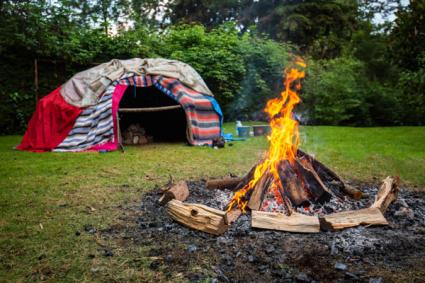< Back to all interventions for Treatment of Alcohol Use Disorder
Sweat Lodge Ceremony (SLC)
Sweat Lodge Ceremony (SLC) was used as an intervention in combination with treatment as usual.
This intervention utilizes the sweat lodge ceremony in combination with alcohol education classes and individual psychotherapy sessions to target alcohol use in individuals who were incarcerated. The SLC attempts to help participants return to a state of balance through the use of traditional cleansing healing ceremonies. The intervention also was intended to reduce incarceration recidivism. The number of education classes, therapy sessions, or SLCs per participant were not described.

Outcomes
No significant change in alcohol use from pre-intake to follow-up.
This intervention enrolled 190 AI/AN participants and obtained baseline data. Fewer than half of participants provided data at either 3- or 9-month follow-up after release from jail. The 91 participants who provided follow-up data reported drinking on average 4 drinks per occasion, and the majority were drinking at least once a month. Although participants were drinking about 1.5 fewer drinks than at baseline (5.4 vs. 6.8 drinks), this decrease in alcohol use was not significant. Forty-seven percent had been arrested again, and virtually all of these were for alcohol-related offenses.
Costs
Medium start-up costs and low ongoing costs.
Assuming the jail provided basic infrastructure—such as staff to administer the psychotherapeutic and educational groups—the construction of the sweat lodge would be substantial. However, after this initial expenditure, ongoing costs are likely to be low.
Cultural Engagment
Cultural and Tribal engagement was high.
Navajo Nation was responsible for the demonstration program, the Dine’ Center for Substance Abuse Treatment (DCSAT); the focus was to provide culturally competent counseling to patients. The SLC was one of 12 traditional healing ceremonies used by DCSAT. The other ceremonies were not described. The incarcerated persons reported high levels of satisfaction with and benefits from the SLCs.
Participants
Young Adult, Adult, Senior; Native; Male
Setting
Reservation, Rural, Social Services
Delivery
Face-to-Face
Rural, American Indian male adults participated.
The program enrolled 190 incarcerated American Indians individuals, but only 123 participated in the SLCs. All participants were male and ranged in age from 18 to 64 years (mean 30.2 years). The treatment setting was the Navajo Nation Window Rock Jail, where participants were offered jail-based treatment program targeting alcohol use.
Staffing Needs
Not Specified
Traditional counselors delivered the treatment.
Although traditional counselors delivered the intervention, information regarding their credentials was not provided.
Research Design
Pre-/post-intervention data
Developmental stage of research
The addition of a sweat lodge ceremony to incarceration-based treatment is in the early stages.
The SLC intervention is in its early stages of development. Given the difficulties with collecting data, it is hard to draw solid conclusions about the intervention. The study did not include randomization; recruitment was unbalanced; and data were missing from participants not completing the questionnaires. Also, this study did not address the possible impact that the education classes or psychotherapy had on participants.
Potential
There is potential for adding sweat lodge ceremonies in the context of incarceration services.
Using culture as medicine, from an intervention and implementation perspective, is a low-burden effort that can be well received and highly feasible. However, this study does not support the idea that SLCs as a “stand-alone” intervention can promote and maintain recovery. The limited outcomes fail to support the integration into services provided to incarcerated individuals without additional formative work.
References
Gossage JP, Barton L, Foster L, et al. Sweat lodge ceremonies for jail-based treatment. J Psychoactive Drugs. 2003;35(1):33-42. https://pubmed.ncbi.nlm.nih.gov/12733756. https://doi.org/10.1080/02791072.2003.10399991.
< Back to all interventions for Treatment of Alcohol Use Disorder

